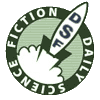
Objects in the Nobel Museum, 2075
by Marissa Lingen
Welcome to the Nobel Museum! We're so glad that you've made us part of your day. Since the beginning, we've been asking Nobel Prize winners to donate an object that says something about their Nobel journey: their research, receiving the prize itself, or themselves as people. Our original location on the sadly much reduced island of Gamla Stan forced us to cycle through these objects, displaying only a small selection at a time, but the current location allows you to browse all the prize winners from Rontgen to Okorie. We hope you enjoy your visit!

Cross-section of jerboa spine. Provided by Farida Mohammed, winner of the prize for Physiology/Medicine, 2038. Mohammed chose a very direct representation of her team's research into the jerboa's range with the increased heat and desertification of her native North African region. Mohammed's research into how the jerboa's physiology allowed it to thrive and expand in this climate provided crucial insights for the medical/genetic adaptation of humans to Earth's rising temperature.

Clam shell, Martha's Vineyard. Provided by Alisdair MacReady-Applebaum, winner of the prize for Chemistry, 2048. MacReady-Applebaum grew up going to Martha's Vineyard when it still existed. Its disappearance motivated him to go into oceanography, where his team's work on acid balance in deep trenches was groundbreaking. By then Martha's Vineyard was unrecognizable from his childhood days.

Worn straw sandal. Provided by Lauren Sekibo, winner of the prize for Peace, 2032. The precipitous rise of the anti-fascist group Wave of Humanity startled the entire planet in its influence in African politics in the '20s. No one was surprised when Sekibo won the Peace Prize. The sandal was a bit of a mystery, as she was always known for her crisp, polished personal presentation, and she, alone among Prize winners, has declined to explain it. She is now a very elderly woman, living in the prosperous city of Luanda. The Museum writes to her every year, but hopes of ever understanding what this sandal means to her and to Africa's peace movement in the face of its staggering climate change grow dimmer as she grows older.

Carved mangrove wood face, island of Pohnpei. Provided by Tala Ramos, winner of the prize for Literature, 2070. Ramos, like Mario Vargas Llosa before her in 2010, had a variety of talismans to inspire her writing. While his were hippos (see 2010 portion of exhibit for further discussion) and hers a variety of faces made from mangrove wood from all over the Pacific, fruitful literary comparison has been drawn from their relative use of whimsical, bright physical objects to bring about varied compositions. While one might have expected Ramos to make pointed remarks about the disappearance of the mangrove habitats, instead she uses the tenacity of the mangrove in shoring up tiny islands as a metaphor for hope.

Ear of corn. Provided by Barbara McClintock, winner of the prize for Medicine/Physiology, 1983. The mobile genetic elements described in this ear of corn of course later became crucial in the application of human genetic research to inhabiting a changed Earth, but fortunately it was recognized as vital insight even before its technical applications were fully understood.



